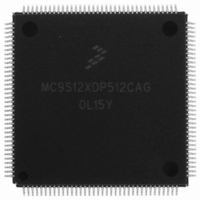MC9S12XDP512CAG Freescale Semiconductor, MC9S12XDP512CAG Datasheet - Page 578

MC9S12XDP512CAG
Manufacturer Part Number
MC9S12XDP512CAG
Description
IC MCU 512K FLASH 144-LQFP
Manufacturer
Freescale Semiconductor
Series
HCS12r
Datasheet
1.MC9S12XD64CAA.pdf
(1348 pages)
Specifications of MC9S12XDP512CAG
Core Processor
HCS12X
Core Size
16-Bit
Speed
80MHz
Connectivity
CAN, EBI/EMI, I²C, IrDA, LIN, SCI, SPI
Peripherals
LVD, POR, PWM, WDT
Number Of I /o
119
Program Memory Size
512KB (512K x 8)
Program Memory Type
FLASH
Eeprom Size
4K x 8
Ram Size
32K x 8
Voltage - Supply (vcc/vdd)
2.35 V ~ 5.5 V
Data Converters
A/D 24x10b
Oscillator Type
External
Operating Temperature
-40°C ~ 85°C
Package / Case
144-LQFP
Processor Series
S12XD
Core
HCS12
Data Bus Width
16 bit
Data Ram Size
32 KB
Interface Type
CAN/I2C/SCI/SPI
Maximum Clock Frequency
40 MHz
Number Of Programmable I/os
119
Number Of Timers
12
Maximum Operating Temperature
+ 85 C
Mounting Style
SMD/SMT
3rd Party Development Tools
EWHCS12
Development Tools By Supplier
EVB9S12XDP512E
Minimum Operating Temperature
- 40 C
On-chip Adc
2 (24-ch x 10-bit)
Cpu Family
HCS12
Device Core Size
16b
Frequency (max)
40MHz
Total Internal Ram Size
32KB
# I/os (max)
119
Number Of Timers - General Purpose
12
Operating Supply Voltage (typ)
2.5/5V
Operating Supply Voltage (max)
2.75/5.5V
Operating Supply Voltage (min)
2.35/3.15V
Instruction Set Architecture
CISC
Operating Temp Range
-40C to 85C
Operating Temperature Classification
Industrial
Mounting
Surface Mount
Pin Count
144
Package Type
LQFP
For Use With
DEMO9S12XDT512E - BOARD DEMO FOR MC9S12XDT512EVB9S12XDP512E - BOARD DEMO FOR MC9S12XDP512
Lead Free Status / RoHS Status
Lead free / RoHS Compliant
Available stocks
Company
Part Number
Manufacturer
Quantity
Price
Company:
Part Number:
MC9S12XDP512CAG
Manufacturer:
Freescale Semiconductor
Quantity:
10 000
Part Number:
MC9S12XDP512CAG
Manufacturer:
FREESCLA
Quantity:
20 000
- Current page: 578 of 1348
- Download datasheet (8Mb)
Chapter 15 Background Debug Module (S12XBDMV2)
15.4
The BDM receives and executes commands from a host via a single wire serial interface. There are two
types of BDM commands: hardware and firmware commands.
Hardware commands are used to read and write target system memory locations and to enter active
background debug mode, see
includes all memory that is accessible by the CPU.
Firmware commands are used to read and write CPU resources and to exit from active background debug
mode, see
accumulator (D), X index register (X), Y index register (Y), stack pointer (SP), and program counter (PC).
Hardware commands can be executed at any time and in any mode excluding a few exceptions as
highlighted (see
“Security”). Firmware commands can only be executed when the system is not secure and is in active
background debug mode (BDM).
15.4.1
If the user resets into special single chip mode with the system secured, a secured mode BDM firmware
lookup table is brought into the map overlapping a portion of the standard BDM firmware lookup table.
The secure BDM firmware verifies that the on-chip EEPROM and Flash EEPROM are erased. This being
the case, the UNSEC and ENBDM bit will get set. The BDM program jumps to the start of the standard
BDM firmware and the secured mode BDM firmware is turned off and all BDM commands are allowed.
If the EEPROM or Flash do not verify as erased, the BDM firmware sets the ENBDM bit, without asserting
UNSEC, and the firmware enters a loop. This causes the BDM hardware commands to become enabled,
but does not enable the firmware commands. This allows the BDM hardware to be used to erase the
EEPROM and Flash.
BDM operation is not possible in any other mode than special single chip mode when the device is secured.
The device can only be unsecured via BDM serial interface in special single chip mode. For more
information regarding security, please see the S12X_9SEC Block Guide.
15.4.2
The system must be in active BDM to execute standard BDM firmware commands. BDM can be activated
only after being enabled. BDM is enabled by setting the ENBDM bit in the BDM status (BDMSTS)
register. The ENBDM bit is set by writing to the BDM status (BDMSTS) register, via the single-wire
interface, using a hardware command such as WRITE_BD_BYTE.
578
Functional Description
Section 15.4.4, “Standard BDM Firmware
Security
Enabling and Activating BDM
Section 15.4.3, “BDM Hardware
Section 15.4.3, “BDM Hardware
MC9S12XDP512 Data Sheet, Rev. 2.21
Commands”) and in secure mode (see
Commands”. The CPU resources referred to are the
Commands”. Target system memory
Freescale Semiconductor
Section 15.4.1,
Related parts for MC9S12XDP512CAG
Image
Part Number
Description
Manufacturer
Datasheet
Request
R

Part Number:
Description:
16-BIT MICROPROCESSOR FAMILY
Manufacturer:
FREESCALE [Freescale Semiconductor, Inc]
Datasheet:
Part Number:
Description:
Manufacturer:
Freescale Semiconductor, Inc
Datasheet:
Part Number:
Description:
Manufacturer:
Freescale Semiconductor, Inc
Datasheet:
Part Number:
Description:
Manufacturer:
Freescale Semiconductor, Inc
Datasheet:
Part Number:
Description:
Manufacturer:
Freescale Semiconductor, Inc
Datasheet:
Part Number:
Description:
Manufacturer:
Freescale Semiconductor, Inc
Datasheet:
Part Number:
Description:
Manufacturer:
Freescale Semiconductor, Inc
Datasheet:
Part Number:
Description:
Manufacturer:
Freescale Semiconductor, Inc
Datasheet:
Part Number:
Description:
Manufacturer:
Freescale Semiconductor, Inc
Datasheet:
Part Number:
Description:
Manufacturer:
Freescale Semiconductor, Inc
Datasheet:
Part Number:
Description:
Manufacturer:
Freescale Semiconductor, Inc
Datasheet:
Part Number:
Description:
Manufacturer:
Freescale Semiconductor, Inc
Datasheet:
Part Number:
Description:
Manufacturer:
Freescale Semiconductor, Inc
Datasheet:
Part Number:
Description:
Manufacturer:
Freescale Semiconductor, Inc
Datasheet:
Part Number:
Description:
Manufacturer:
Freescale Semiconductor, Inc
Datasheet:











